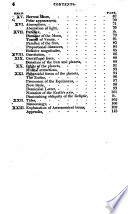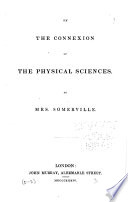 | Hervey Wilbur - Astronomy - 1831 - 170 pages
...the squares of the periods, in which any two pla* nets complete their revolutions in their orbits, are proportional to. the cubes of their mean distances from the Sun. \ This proportion requires illustration. Let the period of tha Earth's revolution, be called 12 months,... | |
 | Antislavery movements - 1833 - 370 pages
...planets. This discovery of Kepler's was, that the squares of the periodical times of the planets are as the cubes of their mean distances from the sun. That is to say, if you multiply the numbers expressing the times of going round, each by itself, the products... | |
 | Mary Somerville - Physical science - 1834 - 390 pages
...having the sun in one of their foci ; and third, that the squares of the periodic times of the planets are proportional to the cubes of their mean distances from the sun. These laws extend also to the satellites. Latent heat. Caloric existing in all bodies, which is not... | |
 | Hervey Wilbur - Astronomy - 1834 - 172 pages
...that the squares of the periods, in which any two planets complete their revolutions in their orbits, are proportional to the cubes of their mean distances from the Sun. This proportion requires illustration. Let the period of the Earth's revolution, be called 12 months,... | |
 | Mary Somerville - Physical sciences - 1834 - 484 pages
...having the sun in one of their foci ; and third, that the squares of the periodic times of the planets are proportional to the cubes of their mean distances from the sun. These laws extend also to the satellites. Latent heat. Caloric existing in all bodies, which is not... | |
 | Hugh Murray - Commercial geography - 1837 - 612 pages
...From Kepler's third law, we know that the squares of the periodical times of any two of the planets are proportional to the cubes of their mean distances from the sun. This law is independent of the eccentricities of the orbits; and the same relation would subsist between... | |
 | 1838 - 1050 pages
...proportional to the times ; that they move in elliptical orbits, having the sun in one focus ; and that the squares of their periodic times are proportional to the cubes of their mean distances, which are now generally known by the name of Kepler's laws. KEPPEL, AUGUSTUS.— This gallant English... | |
 | William Augustus Norton - Astronomy - 1839 - 530 pages
...of which the sun occupies one of the foci. 3. The squares of the times of revolution of the planets are proportional to the cubes of their mean distances from the sun, or of the semi-major axes of their orbits. These laws are known by the denomination of Kepler's Laws.... | |
 | Roswell Park - Best books - 1841 - 722 pages
...the sun, pass over equal areas in equal times; and 3. The squares of their times of annual revolution are proportional to the cubes of their mean distances from the sun. By the second law, the planets move slowest when farthest from the sun ; as the radius vector, being... | |
 | Ezra Otis Kendall - Astronomy - 1845 - 408 pages
...in making a revolution. Kepler discovered that the squares of the periodic times of any two planets are proportional to the cubes of their mean distances from the sun. Take, for example, the Earth and Mars, whose periods are 365.2504 and 686.9796 days, and whose distances... | |
| |